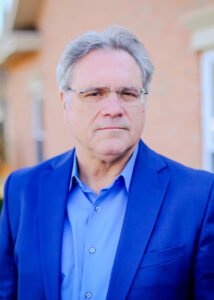“Biggest challenge is workforce,” says CEO and president of Iroquois Healthcare Association and Iroquois Healthcare Alliance about healthcare industry
By Mary Beth Roach
 Q: What is the Iroquois Healthcare Association and what is its mission?
Q: What is the Iroquois Healthcare Association and what is its mission?
A: We’re a health-care association of 50-some hospitals in 32 Upstate New York counties. We were created when the Central New York Hospital Association and the Northeastern New York Hospital Association got together and decided to merge. The reason we gave it the Iroquois name is it’s the same kind of territory as the Iroquois nation. The Iroquois nation was one of the first groups of tribes that got together and worked together. And that’s what the hospitals are trying to do. We mostly do advocacy for hospitals in our membership. We have hospitals, both small and large, rural areas, big cities. We make sure what Washington and Albany do, when it comes to regulations, financing, Medicare and Medicaid, that hospitals in our membership are treated fairly.
We do educational programs for our membership and staff. We collect data and we give the data back to the hospitals on certain things so they can compare themselves to each other and see how they’re doing. We have a for-profit subsidiary that does purchasing for hospitals. Right now, we’re really deep into the healthcare workforce shortage. We’ve been working on that for a long time, but it’s gotten worse with the pandemic and the vaccination issues. A lot of our hospitals are right on the edge of trying to get more staff and we’re trying to help with that.
Q: Can you give us an idea of how extensive your coverage area is?
A: We have 32 counties. We go from Columbia County, which is just south of the Capital Region, up to Plattsburgh, and over to Watertown and down to Binghamton. We don’t go into the city of Rochester.
Q: In what ways have you helped healthcare institutions navigate through the COVID-19 pandemic?
A: They [the healthcare institutions] are the ones doing all the work. We’re collecting data and we talk to the Health Department and the Governor’s Office. During the height of the pandemic, we were on calls almost daily, seven days a week, trying to make sure that the department of health and the governor’s staff knew how things were going in the hospitals, where there were bed shortages and where there were supplies of PPEs, where there were shortages. That was a pretty intense time. And the COVID pandemic was different because it started in New York City downstate and we really weren’t experiencing it at that level upstate. Then, all of a sudden, a few months later, we started to get a surge upstate. While they were scrambling downstate, we were furloughing staff off in our hospitals. We’re communicating all this to the Department of Health on a regular basis, so they understand what’s going on out there.
We just made sure, if there was a hospital that had a staffing problem or a PPE problem, we communicated that and we tried to locate stuff to help them out. We are a go-between between the Department of Health and the hospitals themselves. We also had the hospitals talk to each other.
Q: How do you interface with the state government regarding these healthcare issues and concerns, especially during the pandemic?
A: We do it in a number of ways. We work with the Department of Health. We work with the governor’s office — there are people in the Governor’s office who are healthcare deputies – and we also inform the State Legislature –— the Senate and the Assemblypeople. We communicate with them on a regular basis. When they’re in session, we usually make visits down there to their offices or in their regional offices. We have an agenda for the session, like our workforce and how to make it easier for hospitals to recruit and retain workforce. The upstate hospitals that we represent have different needs than the downstate hospitals.
Q: What are some of the biggest challenges that you see in your role facing the healthcare industry today?
A: I think the biggest challenge is workforce. It takes a while to get healthcare workers certified and educated and trained. We’re working with educational organizations so we can get more healthcare workers into the system. It’s also finances. There are three ways hospitals get paid — insurance companies, Medicaid and Medicare. If Medicaid and Medicare aren’t paying their fair share, that causes hospitals to really have a problem financially. The future is trying to make sure we have adequate financing and adequate staff.
Q: Are there any specific programs or initiatives that you’re doing or planning to do in the near future to combat some of these issues.
A: The Caring Gene — we have a campaign on social media, on TV and radio basically saying if you have the “caring gene,” you should be working in healthcare. Certain people have that gene. We made a whole campaign, trying to generate more interest in people wanting to get into healthcare.
Q: How has the response been?
A: We have a lot of people that are interested. But the one piece we’re trying to figure out is how many people actually got hired. It generated a lot of interest. It’s very difficult because the hospitals and nursing homes are recruiting on their own. It is very difficult to know if it was our campaign or it was their ability to get the word out there. We’re trying to figure out ways to better document that.
Q: Your organization has sponsored some job fairs currently. Will you be extending those job fairs into November?
A: Yes, because I think for whatever reason, we’re not getting enough people participating who are looking for jobs. We’ve got a number of vacancies at all our providers and yet we’re not generating enough interest in some of these job fairs. I think this is a national debate why people aren’t looking for work right now. We’re going to continue to do the job fairs because we believe there’s a group of people that would be interested in working in a healthcare environment.
Q: The job fairs are virtual. If someone would be interested in knowing more, are the job fairs posted on your website?
A: They’re on the Iroquois.org website and the CaringGene.org website.
Q: What do you see for the future for the healthcare industry in Upstate New York?
A: There will be consolidation of healthcare services. The workforce will have to be rethought because we don’t enough that are in the pipeline. There’s going to be more telehealth. It’s really moving in that direction. Hospitals are going to be working with each other in a more efficient way.

